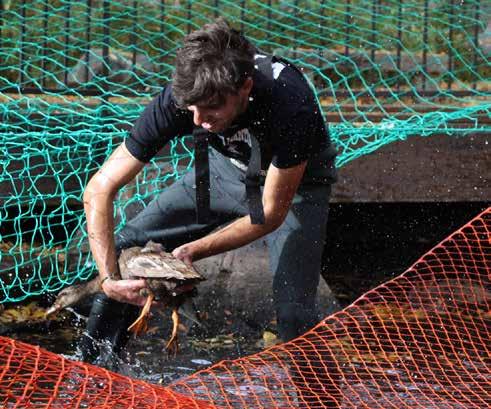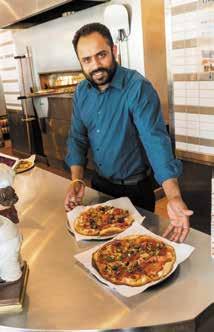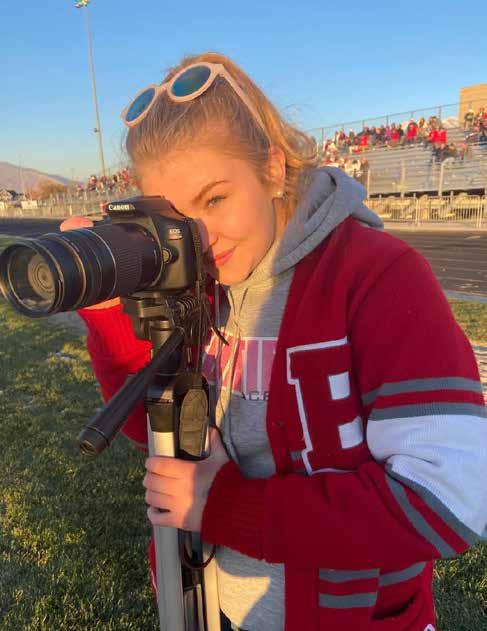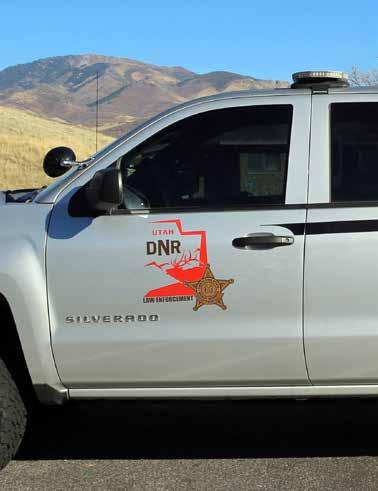SPECIAL OLYMPICS ATHLETES AND PEER PARTNERS CREATE BONDS THAT EXTEND BEYOND THE FIELD
Byline
It was a great day as students of all abilities paraded onto the field at the Legacy Events Center to play in a Unified Sports Soccer Tournament Sept. 22. The program brings together Special Olympics Utah athletes (individu als with intellectual disabilities) and partners (individuals without intellectual disabilities) on teams for training and competition.
The Davis School District and the Davis Education Foundation partnered with First Lady Abby Cox a year ago for her “Show Up” initiative that included expanding the Unified Sports Program in schools around the state.

“This is the best part of my day, my week, my month,” said Davis School District Superintendent Dr. Dan Linford. “It’s a great program. As we know we’re paying teachers to teach the standard curriculum but we know that extracurricular things like sports give critical life skills. You can’t teach that in the classroom. I thank the coaches, the athletes and the peer students.”
Smart Rain, a smart irrigation technology company donated $20,000 through its Smart Rain for Smart Kids program to make the tournament possible. “We thank Smart Rain for their donation,” said Linford. “It helped pay for uniforms. We love you.”
“We’re tickled to be here,” Smart Rain Founda
By Becky Ginos | becky.g@davisjournal.comSubscribe now to the Davis Journal and get local news every week.
today at subscribe.davisjournal.net
 Special Olympic athlete Ellie Snow makes a shot on goalie Keelie Lund for the Farmington High team. High schools from all over the district played in the Unified Sports Soccer Tournament held Sept. 22.
Special Olympic athlete Ellie Snow makes a shot on goalie Keelie Lund for the Farmington High team. High schools from all over the district played in the Unified Sports Soccer Tournament held Sept. 22.


Getting to Know Dr. Heaton

Jared Heaton is an attentive and thorough dermatologist, serving his patients in Davis County. Dr. Heaton is Board-certified in dermatology, and he is currently a member of the American Society of MOHS Surgeons.




Dr. Heaton prides himself in serving all patient populations and treating all areas of dermatology from children through retirement age. He places a strong empahsis on catering to the retirement population in his community as skin cancer is more prevalent in this age group.
Dr. Heaton earned an undergraduate degree in International Relations with a minor in Asian Studies from Brigham Young University (BYU). His medical degree is from Arizona College of Osteopathic Medicine (AZCOM). He completed both his internship and medical residency in Tampa, Florida.


In his spare time, Dr. Heaton enjoys mountain biking, snowboarding, parafoil kite flying, and spending time with his wife and three children.

Centerville Police Department works to retain officers amid challenges
Linda Petersen | lpetersen@mycityjournals.comMost people would agree that it has never been more difficult to be in law enforcement. Even in a communi ty like Centerville where police officers are largely supported, the national trend of disrespect for them has crept in. It’s a trend that has carried a significant price, Police Chief Paul Child told Mayor Clark Wilkinson and the city council at a Sept. 13 work meeting.
“I had officers, after enduring 2020 and all the riots, there were several that were just ready to hang it up and just do another career … but it was those types of things that kept them going,” he said re ferring to efforts to honor local police of ficers. “When they come to work, they’re yelled at at work; they go home; they turn on the TV and what’s going on on the TV, and then their kids are asking them and they’re just getting the 24/7 of it, and they were just done.”
To help law enforcement personnel deal with many of these challenges the de partment has formed a peer support team. Among other resources the team provides debriefs for officers who deal with high stress situations such as trials and lawsuits.
Child cited a recent traumatic incident in a neighboring community where a child was run over. A debrief held by the team and a mental health professional helped Center ville officers process the incident, he said.

Officers from Bountiful and Woods Cross also participated in the debrief.
To help personnel cope with the diffi culties of the job, the department has also signed a contract with Previdence, a men tal health service that provides twice-year assessments to law enforcement agencies. Under the program, Previdence adminis
ters data-based assessments that officers complete, which are scored by a trained clinician to determine an appropriate mode of care when needed. A member of the company’s liaison team follows up with individual officers, if necessary, to connect them to a trauma-trained therapist. The process is completely confidential between the officers and Previdence, Child said. So far about half of the department has partic ipated in the voluntary program. Child said that he has already seen such a positive re sponse that the department is considering making it mandatory going forward.
Community efforts that show appreci ation also mean a lot to the officers who are under constant stress, he said in re sponse to a question from Councilmember Bill Ince on how the council and the com munity could help. He encouraged them to join officers for ride alongs and to sit down and talk with them.
“You can’t throw enough money at them to compensate for something like that so that kind of support is critical,” Child said. “The support from the council, knowing that the council supports them, is supercritical, and engaging with them is really important.”
While a significant pay raise imple mented in December was appreciated by officers, it really was a temporary fix as many police departments across the state have implemented similar pay raises, Child said.
“What we’re seeing now is everybody else did the same thing, and now we’re falling behind again,” he said. “Going forward in the next year, we’re going to have to look at that and make sure we’re not falling behind with our competition –
which is everybody.”
The department is currently fully staffed but there is no leeway when officers go on vacation, are sick, retire or leave, which means all officers are stretched thin, Child said. It’s a situation that is going to be difficult to remedy with a particularly tight job market in law enforcement, he said.
“I went through four hiring pools to try to find someone that was up to our ex
pectations – and it took a year,” Child said of the last opening he filled. “And within that year, everyone is being taxed; we’re working overtime. We’re constantly hav ing to move people around …We’re con stantly having to do those types of adjust ments, and that’s where it could be helpful to have some more available manpower resources so that we’re not doing so much of that moving people around constantly to cover shifts.” l
THE CITY
THE CITY JOURNALS TEAM
The City Journal is a monthly publication dis tributed directly to residents via the USPS as well as locations throughout Centerville and Farm ington
For information about distribution please email brad.c@thecityjournals.com or call our offices.
Rack locations are also available on our website.
The views and opinions expressed in display ad vertisements do not necessarily reflect or repre sent the views and opinions held by Loyal Perch Media or the City Journals. This publication may not be reproduced in whole or in part without the express written consent of the owner.
© 2019 Loyal Perch Media, Inc.

media
PUBLISHER
Bryan Scott | bryan.s@thecityjournals.com
EDITOR
Tom Haraldsen | tom.h@davisjournal.com
ASSOCIATE EDITOR
Becky Ginos | becky.g@davisjournal.com
DIRECTOR OF ADVERTISING
Ryan Casper | ryan.c@thecityjournals.com 801-254-5974
ACCOUNT EXECUTIVES
Mieka Sawatzki | mieka.s@thecityjournals.com
Jason Corbridge | jason.c@thecityjournals.com
CIRCULATION COORDINATOR
Brad Casper | brad.c@thecityjournals.com 801-254-5974
Rack locations are also available on our website.
To subscribe to the weekly Davis Journal: subscribe.davisjournal.net
270 S. Main St. Suite #108, Bountiful UT 84010 801.901.7962
EDITORIAL & AD DESIGN
Ty Gorton Anna Pro
THE CITY JOURNAL
270 S. Main St. Suite #108 Bountiful, UT 84010
Phone: 801-901-7962
MISSION STATEMENT
Our mission is to inform and entertain our community while promoting a strong local economy via relevant content presented across a synergetic network of print and digital media.
PUBLISHER
Designed, Published, & Distributed by
Children gather to look inside a Centerville Police car at the Davis Remembers 911 event. The department has formed a peer support team to help officers deal with mental health issues that may come up from doing the job. Courtesy photoVicar Lyn Briggs leaving Centerville for Houston service
 By Tom Haraldsen | tom.h@davisjournal.com
By Tom Haraldsen | tom.h@davisjournal.com
Aug. 28 was a sad day for congre gants of the Episcopal Church of the Resurrection in Centerville, as well as many others in the community. The longtime Vicar of the church, Lyn Briggs, gave her final service last month before leaving for Texas. She has been called to serve in an Episcopal Church in the Lone Star State.
“I moved to Salt Lake City from Ne braska in 1977, so I’m practically a Utahn myself,” she said with a smile, even as she was busily packing the next Monday. “I served as Vicar of Resurrection from 2009 until this week. I left my position as associ ate rector at St. Paul’s Church in Salt Lake City to lead this congregation.”
Her final service included many com munity members who are not part of her con gregation, including Bountiful Mayor Kend alyn Harris and local businessman Ron Burt, who serves on the Davis County Interfaith Community Council and worked with Vicar Briggs for many years.

“It was wonderful to work with Lyn,” Burt said. “She has been such a blessing to the community and we’ve loved working with her whole congregation. She’s going to be greatly missed by so many of us.”
Burt pointed to the monthly community dinners which Vicar Briggs started and co
ordinated for almost 10 years, dinners that brought together people from many different faiths. l
MEMORY CARE


We are located in the heart of Murray and are excited to improve the lives of our residents and their families by offering Independent Living, Assisted Living and Memory Care.






 Vicar Lyn Briggs gives her final service at the Episcopal Church of the Resurrection in Centerville last month.
Bountiful Mayor Kendalyn Harris and business man Ron Burt visited with Vicar Briggs following her sermon last month. They were among many community members who attended the service. Photos courtesy of Dan Bammes
Vicar Lyn Briggs gives her final service at the Episcopal Church of the Resurrection in Centerville last month.
Bountiful Mayor Kendalyn Harris and business man Ron Burt visited with Vicar Briggs following her sermon last month. They were among many community members who attended the service. Photos courtesy of Dan Bammes
Several events are being organized by the city’s park and recreation depart ment and the Whitaker Museum for fam ilies this fall.
On three Thursdays in October, Oct. 6, 20 and 27 they are sponsoring local art ist and cottage booths at the museum, 168 N. Main, from 5 to 8 p.m. In addition, local gardeners can bring excess produce from their gardens to swap with others or just to share with the community.
On Tuesday, Oct. 11 at 7 p.m. at the city offices, 250 N. Main St., the muse um will continue its Keeping Our Stories Alive series with a presentation by Patrick
Fall fun planned for Centerville families
Linda Petersen | lpetersen@mycityjournals.comEdward Connor about the history of Fort Douglas. The museum will host a cemetery tour where local storyteller Karl Behling will share tales of some of Centerville’s former residents who are buried there at the cemetery at 650 East 400 South as part of the series on Oct. 27 at 7 p.m. Reserva tions required; call the museum to register.
This year’s Fall Pumpkin Festival, which is being presented by Rocky Moun tain Power, will have a pumpkin theme. Local families can enjoy pumpkin bowl ing, pumpkin carving stations and pump kin crafts at the Whitaker Museum on Oct. 24 from 5:30 to 9 p.m. They can bring

pre-carved pumpkins from 5 to 5:30 p.m. or they may carve pumpkins provided for free onsite (limited number available). There will be prizes for the best pumpkins based on age and ability levels. This is the first year Rocky Mountain Power has sponsored the event.
“They’ve been great; they reached out to us. This has been a year in the mak ing, Community Services Manager Bryce King said. “They made it happened; it has worked out well.”
Coming up in November, the city will hold its annual Tree Lighting Festival on Monday, Nov. 28 from 6 to 8 p.m. at Smith
Park (details to be announced). The Whita ker museum will be closed Thanksgiving week. Then it will open for the annual Pioneer Christmas on Tuesdays, Nov. 29, Dec. 6 and 13. This free event will include photos and a visit with Santa Claus (be tween 4 and 7 p.m.) along with old-fash ioned Christmas activities. Reservations are required to guarantee a spot; call the museum at 801-335-8843 to register.
The museum will be closed the week between Christmas Day and New Year’s Day so volunteers can be with their fami lies, museum director Lisa Sommers said. l

Wasatch Wanderers rescues abandoned exotic pets, ducks and geese
 By Peri Kinder | peri.k@thecityjournals.com
By Peri Kinder | peri.k@thecityjournals.com
When people think of animal rescue, they usually think about the thousands of abandoned dogs or cats waiting to be placed in forever homes. But Wasatch Wanderers rescue a different type of animal.
Although Adison Smith and co-found er Kade Tyler have been rescuing animals for more than 10 years, it wasn’t until last September that they created the nonprofit Wasatch Wanderers to help domestic water fowl, farm animals and exotic pets.
“I’ve always been very passionate about helping animals because they don’t have a voice for themselves,” Smith said. “We just recognized there was a big need for farm and exotic animal rescue.”
Last fall, Smith was contacted by Weber State University to rescue more than 60 ducks and geese stranded on the school’s campus. Water for the animals was drying up and the waterfowl were being attacked by dogs.
Geese had been at WSU for several years, but as the birds reproduced, and as peo ple dropped off their pet geese and ducks on campus, the number of birds had increased, creating a problem at the school.
“For years, these geese had been seen as the Weber State unintentional mascot. They’d put the geese on shirts and hats and COVID masks,” Smith said. “I organized a rescue team and found homes for the geese.”
That’s when she decided to create Wasatch Wanderers, and during the last year, the organization has rescued more than 500 domestic waterfowl.
Smith said people don’t realize pet ducks and geese have been genetically altered with wings too small for their bodies. They get too fat to fly to safety. Because they can’t sustain flight, they don’t migrate and get stuck in ponds when the water freezes.
“They rely on humans to keep them alive. You’ll see a lot of dead waterfowl be cause they can't leave and they’ve become an easy target for predators,” Smith said. “Peo ple just don’t know they can’t fly or forage on their own.”
The goal of Wasatch Wanderers is to re move domestic waterfowls from places that aren’t safe and put them in forever homes. But it’s not just geese and ducks rescued by the group, they also take in pigs, chickens, cows, hamsters, turtles and fish.
Smith is often contacted by shelters across the state who have a rooster, pig or duck that’s going to be euthanized. She takes those animals and gives them to one of the 50 foster homes willing to take in farm animals.
They recently saved a pig from a shel ter near Vernal and rescued an additional four pigs from California. Wasatch Wanderers paid for a volunteer to transport the pigs to a foster home and got the animals medical care, including one pig that had eight babies after it was rescued.
“We travel basically everywhere in Utah
where there’s a need,” she said. “Wasatch Wanderers focuses on abandoned, neglected and unwanted animals. Our goal is to educate the public and get them to treat and see ani mals differently.”
It can get overwhelming when so many animals need a home. There are currently 85 roosters in the group’s care, more than 150 waterfowl, lots of guinea pigs and hamsters, and they’ve stopped accepting rabbits be cause they can’t afford the medical care for all the rabbits they receive.
Wasatch Wanderers also rescues aban doned turtles and goldfish. In the last year, the group has saved nearly 70 turtles that have been abandoned in waterways. Smith said people don’t know that goldfish and tur tles are an invasive species and damaging to wildlife.

“These are living beings and they have needs and if you can’t meet those, don’t buy them,” Smith said. “Not only is it harmful and cruel to that animal to do that, it’s also ille gal. It’s actually a crime in the state of Utah to abandon any domestic animal, even some thing as small as a goldfish.”
Currently, the organization is 100% fos ter-based, but Smith and Tyler hope to pur chase property to create an animal sanctuary when land becomes more affordable. All the money for medical care, food and transpor tation comes out-of-pocket or through dona tions.
To contribute to Wasatch Wanderers, to become a foster or for more information, visit WasatchWanderers.org.
“There is a resource available to pet owners who are in over their head. Don’t abandon, reach out to a rescue,” Smith said. “The biggest change we want to make is edu cating the public and preventing the problem at the source. Prevent those impulsive buys because that’s what so many do when they abandon their animal. Make more responsible decisions. That’s what adults are supposed to do.”l
Kade Tyler and Adison Smith, founders of Wasatch Wanderers, rescue ducks, geese, farm animals and exotic pets throughout the state. Photos courtesy of Holly CluffWe travel basically ev erywhere in Utah where there’s a need. Wasatch Wanderers focuses on abandoned, neglected and unwanted animals. Our goal is to educate the public and get them to treat and see animals differently.
Adison Smith
DWR seeking Utahns to adopt desert tortoises
SALT LAKE CITY—The Utah Di vision of Wildlife Resources currently has several desert tortoises available for adop tion and is accepting applications.


Mojave desert tortoises, native to areas north and west of the Colorado River in Ar izona, Utah, Nevada and California, were listed as threatened under the Endangered Species Act in 1990. As such, desert tortois es are protected under federal and state laws. In Utah, it is illegal to collect or remove des ert tortoises from the wild. It is also illegal to release captive tortoises back into the wild or to transport them into Utah without the prop er certifications.
Washington County is the native range of the Mojave desert tortoise in Utah. It’s also an area with a lot of growth and recre ation, which leads to more human-tortoise encounters. The DWR occasionally comes into possession of desert tortoises for a va riety of reasons:
• Someone illegally removed a desert tortoise from the wild.

• A wild tortoise wandered into an urban area or was found outside its native range where it would not survive.
• Someone was illegally housing a des ert tortoise. If a desert tortoise owner moves from another state into Utah, they must ap ply for the proper certifications in order to bring their tortoise with them; otherwise,
they must return the tortoise to an approved adoption facility within their previous state.
• A wild tortoise that was adopted is be ing surrendered due to the family relocating.
“Removing tortoises from the wild can harm wild populations by reducing their ability to reproduce and sustain themselves on the landscape,” said DWR Wildlife Bi ologist Ann McLuckie. “Tortoises that are removed from the wild cannot be released back into the wild, due to a risk of intro ducing diseases, especially if they’ve been kept in a home with other animals. They are susceptible to a density-dependent disease called upper respiratory tract disease, which presents like pneumonia.”
The Utah Desert Tortoise Adoption Pro gram began in the 1990s, after tortoises were placed on the Endangered Species list. This year, the DWR has received almost 20 desert tortoises that are now available for adoption.
If you are interested in adopting a tortoise, you should do the following:
• Submit an application to tortoise@ utah.gov and pay the $10 handling fee.

• Design a safe outdoor and indoor envi ronment for a tortoise.

• Once you are approved for an adop tion, you will pay the $75 Certificate of Reg istration fee.
• Be aware that tortoises can live 60-70 years, and note that you are responsible for
all veterinarian costs.
• Note that you must live in Utah to adopt a desert tortoise from the DWR, and you can’t live in Washington, Kane or Iron counties.
“Captive tortoises make great pets,” McLuckie said. “They have their own unique personality, they will gladly eat the weeds in your backyard and they are fairly independent as long as they have shade and food. They also hibernate for roughly five
months out of the year, making them a fairly low-maintenance pet.”
In Utah, the majority of desert tortois es reside in the Red Cliffs Desert Reserve, where there are roughly 2,000 adult tortois es. The population has not yet recovered to the numbers it had before wildfires scorched the area in 2005. However, during the last few years, the population has remained rela tively stable. l
Have asthma? Nothing works? Come see us!

Dr. Hendershot has more than a decade of experience in the field of Allergy, Asthma, & Immunology and over 5 years of experience treating the most complicated food allergies. With training at National Jewish Health, which is often ranked as the #1 respiratory hospital in the country, and a background as both an internist and pediatrician, he is able to effectively care for patients of all ages.
Dr. Hendershot’s patient care philosophy is to use the least amount of medication possible to accomplish the best possible results when treating allergic diseases such as

food allergy, asthma, eczema, and hay fever. He has some unique tools to especially evaluate asthma or chronic cough that is not getting better. He is also unique in his ability in Utah to thoroughly evaluate, manage, and treat many of the complex and unusual causes of chronic cough and respiratory problems triggered by smells, exertion, or intermittent throat swelling especially when related to allergy.
esophagitis
to
Desert tortoises are available for adoption through Utah’s DWR. Courtesy photoCity officials say contract with lobbyist is paying off for Centerville

 Linda Petersen | lpetersen@mycityjournals.com
Linda Petersen | lpetersen@mycityjournals.com


The city of Centerville has renewed its con tract with federal relations consulting firm, The Ferguson Group. It is a relationship that has been very beneficial to the city, Administrative Services Director Jacob Smith told the city council Sept. 13.

Centerville first began contracting with The Ferguson Group two years ago. Since that time, the firm has helped the city obtain a $75,000 Bureau of Reclamation water efficien cy grant for water meter and radio installation. It has also helped the city acquire $1.5 million from congressionally directed spending, (more commonly known as earmarks), toward re placement of the Green Steel Tank, an aging city water storage tank. Another grant applica tion is pending with the Bureau of Reclamation.
The city pays The Ferguson Group a fixed fee of $5,000 per month and covers reimburs able expenses such as travel up to $2,500 an nually. Along with helping the city find and qualify for various federal grants, The Fergu son Group has helped the city engage more ful ly with Utah’s congressional delegation, TFG partner Mike Miller told the city council. It also works to help the city identify private founda tion grants for some projects that do not qualify for federal funding, he said.
“I think it has been a success with The Fer guson Group,” City Councilmember George

McEwan said. “When we originally entered into this engagement, we had some specifics. We said ‘we need to figure out how to get rid of the Green Steel Tank and replace it’ – they came through in spades on that one – and we gave them a whole shotgun list of other things that we said, ‘Hey you’re in the grant community. If you see anything that matches these, please let us know.’ So, from my perspective, when you look at cost output … based on where we stand right now … if the earmark holds, we’re good.”

In the work session prior to that meeting Miller told the council that there is more fund ing than ever before available for various proj ects.
“The pie is much, much larger than it once was,” he said. “There is an incredible amount of funding when you compare it to prior years. In some cases, 10, 15, 20 times as much mon ey is available for certain programs. The city is well-positioned to do well” provided the crite ria meets the city’s situation.
While in the past, federal agencies have followed a very rigid calendar with dispensing grants, with recent changes, currently the grant cycle not really tied to federal fiscal year, he added.

“We’re seeing grants coming out each month,” he said. l



Nature’s Virus Killer
Copper
a virus before it starts
By Priscilla Schnarr www.copperzap.comScientists have discovered a natural way to kill germs fast.

Now thousands of people are using it against viruses and bacteria that cause illness.
Colds and many other illnesses start when viruses get in your nose and multiply. If you don’t stop them early, they spread and cause misery.
Hundreds of studies confirm copper kills viruses and bacteria almost instantly just by touch.
That’s why ancient Greeks and Egyptians used copper to purify water and heal wounds. They didn’t know about viruses and bacteria, but now we do.
“The antimicrobial activity of copper is well established.”

National Institutes of Health.
Scientists say copper’s high conductance disrupts the electrical balance in a microbe cell and destroys it in seconds.
CopperZap® and put it on the market.
Soon hundreds of people had tried it. 99% said copper worked if they used it right away at the first sign of bad germs, like a tickle in the nose or a scratchy throat.
Users Say:
“It works! I love it!”
“I can’t believe how good my nose feels.”
“Is it supposed to work that fast?”
“One of the best presents ever.”
“Sixteen airline flights, not a sniffle!”

“Cold sores gone!”
“It saved me last holidays.
The kids all got sick, but not me.”
The EPA recommended hospitals use copper for touch surfaces like faucets and doorknobs. This cut the spread of MRSA and other illnesses by over half, and saved lives.
“I am shocked! My sinus cleared, no more headache, no more congestion.”
“Best sleep I’ve had in years!”
The strong scientific evidence gave inventor Doug Cornell an idea. He made a smooth copper probe with a tip to fit in the bottom of the nostril, where viruses collect.
When he felt a tickle in his nose like a cold about to start, he rubbed the copper gently in his nose for 60 seconds.
“It worked!” he exclaimed. “The cold never happened. I used to get 2-3 bad colds every year. Now I use my device whenever I feel a sign I am about to get sick.”
He hasn’t had a cold in 10 years.
After his first success with it, he asked relatives and friends to try it. They all said it worked, so he patented


As thousands more tried it, some found other things they could use it against, including: Colds, flu, new viruses and variants, sinus trouble, cold sores, canker sores, strep throat, nighttime stuffiness, morning congestion, nasal drip, skin infections, thrush, warts, styes, and ringworm.

The handle is curved and textured to increase contact.
Copper can kill germs picked up on fingers and hands after you touch things other people have touched.

Scientists placed millions of viruses on copper. “They started to die literally as soon as they touched it,” said Dr. Bill Keevil.
Tarnish does not reduce how well copper works, EPA tests showed.
CopperZap is made in America with pure copper. 90-day full money back guarantee. Price $79.95.
Get $10 off each CopperZap with code UTCJ19

See www.CopperZap.com or call tollfree 1-888-411-6114.




Buy once, use forever.
Statements are not intended as product health claims and have not been evaluated by the FDA. Not claimed to diagnose, treat, cure, or prevent any disease.
advertorial
New research: Copper kills viruses in seconds.Resident’s passion for history serves Centerville well
Linda Petersen | lpetersen@mycityjournals.comThe Whitaker Museum Board and city of ficials recently recognized resident Paul Smith for his years of service. Smith first served on the Centerville Historical Society committee and then later on the Whitaker Museum Board and as its historian.
The author of seven books, Smith worked professionally for The Church of Jesus Christ of Latter-day Saints for 37 years as a seminary and institute teacher and college curriculum developer. He recorded talk tapes for Covenant Communications and wrote articles for church magazines and encyclopedias. After Smith’s retirement, the couple spent three years at the Joseph Smith Academy in Nauvoo where he taught church history and organized student, faculty and staff tours to church history sites covering seven states. He was later a guide on Temple Square, a docent at the Museum of Church History and an ordinance worker in the Salt Lake, Nauvoo and Bountiful Temples. The Smiths served another mission to Salt Lake City and one to Reno, Nevada.
In Centerville Smith used the experience of his long career in education and research and his love of history to benefit his commu nity. He served on the Historic Sites Commit tee and helped gather histories, narrate historic plaques and publish the Centerville historic walking tour and pamphlets.
After the city purchased a historic home in 1994 for a museum on Main Street that had been built by Thomas and Elizabeth Whitaker, Smith became one of the museum’s first board members. In 2019 he became the board histori an and is still serving in that capacity.

Along with writing and publishing the book “The Life and Times of Thomas William Whitaker” and donating its proceeds to the mu seum, Smith has helped restore the museum to its original condition and has written the script for museum tours and a training manual for docents. He has produced a DVD about Thom as Whitaker and a documentary, “Centerville Way of Life,” celebrating Centerville’s history along with a short history DVD for the 2015 centennial celebration. He is currently working on producing a DVD virtual tour of the muse um to allow those who cannot climb its stairs to view the museum digitally.
“Paul is a Centerville treasure,” Whitaker Museum Board Chairman Spencer Packer told Mayor Clark Wilkinson and the city council in a tribute he read at a packed Aug. 16 council meeting. “He has saved the city a great amount of financial resources by his voluntary service and remarkable expertise. Thank you, Paul Smith, for helping us understand that historic preservation is not the past but a map of the past, to be useful to the modern-day traveler.”
“This gathering bespeaks just a little of the love we have for you,” he told Smith as he presented him with a magnifying paperweight signifying 30 years of service to Centerville City. The historian thanked the city for the rec ognition and expressed his appreciation for the many city officials he has worked with over the years.
“Thank you so much,” he said. “I just want to say that if Thomas Whitaker had not been such a character none of this would have happened. And he was. One of the side benefits of working on he and his wife was getting to know you; you’re such a treasure. That’s one of the great blessings of living in Centerville.”
Wilkinson recalled first meeting Smith shortly after he was elected mayor.
“We chatted, but at the time I had no idea of all that you have done throughout your life and here in Centerville,” he said. “I knew a lot, but I am so grateful that Spencer was able to take that time for all of us to be blessed to hear all that you have done and how you have touched people’s lives. That’s just tremendous … Paul deserves to be honored.”
Centerville resident Andy Bavelas also praised Smith’s commitment to the Centerville community.
“Not only is Paul a great scholar but he had a unique connection with people through
out the country and even globally too,” he said. “Paul has always had a unique way to put things together, touch the youth and touch all ages and nationalities – he could project that history in just such a way.” l
Utah women pursuing higher education face challenges
U.S. Census Bureau data show that slightly more Utah women are earning bachelor’s degrees than Utah men (23.4% vs. 22.6%). However, Utah has the most signifi cant educational attainment gap among ad vanced degree holders in the U.S. Nationally, 13% of females and 12.4% of males have a graduate degree, but in Utah, only 9.3% of females have a graduate degree, compared to 14.1% of males.

Recent
To better understand this disparity, a re search team at Utah State University, led by Sojung Lim, associate professor of sociology, in partnership with the USU Utah Woman & Leadership Project, collected quantitative and qualitative data examining the resources and challenges of women pursuing undergraduate or graduate degrees. This report is the first of two and summarizes results from the quanti tative data.
“The goal of this study was to examine the challenges Utah women face when they pursue higher education,” said Susan Madsen, founding director of the UWLP. “Understand ing this will help us learn how to better assist women in attaining higher education, which will, in turn, help in other areas of inequity, in cluding the gender wage gap.”
Study results came from a survey of Utah women 18 or older enrolled in colleges/univer sities pursuing an undergraduate or graduate degree. Participants were recruited through the
registrar’s and graduate offices of Utah uni versities and through social media platforms and professional networks. In June 2022, 907 women completed the survey.
About 30% reported wanting to learn skills necessary for their desired job. One in four respondents said they felt an undergrad uate degree was necessary regardless of their career/life goals, and about 17% chose college to increase potential earnings.
To better understand Utah women’s edu cational aspirations and goals, they were asked if they plan to go to graduate school. Almost half said they were considering it.
“This result is somewhat surprising, giv en that Utah is the state with the largest gender gap in advanced education among all states,” said Lim. “It suggests that challenges and cir cumstances, not ambition and desire, are influ encing the gap.”
Women in undergraduate programs with clear career goals appear to be aware of the benefits of graduate degrees and how they can advance their careers and economic prospects. Conversely, those with unclear career goals and strong family orientations are less interest ed in graduate school. Also, financial and time burdens associated with graduate programs are significant barriers.
Another challenge for Utah women is learning to manage family responsibilities and education. This could be addressed by making
students aware of childcare services and pro viding mentoring programs that target students with children.
A final challenge was women not ful ly understanding their career goals and the pathways that lead to them. Undergraduate students who were less inclined to attend grad
uate school often lacked knowledge about it, i.e., what graduate school entails, resources available, potential benefits, and return on in vestment.
For further information on UWLP pro grams and projects, visit utwomen.org. l
Women facing more challenges than men in efforts to earn a college degree. USU graduation photo by Bronson Teichert Paul Child was honored by the museum board and city officials for 30 years of service to Centerville. Courtesy photo/Gail SmithAsk an Expert – 12 tips to help make sense of home canning

While many people know and under stand basic freezing and dehydrating methods for preserving foods, it becomes a different story when they contemplate bottling.
Food preservation is a science- and research-based practice. It is not the same as creative cooking. When preserving food with water-bath or pressure canning, a kitch en must be turned into a laboratory by fol lowing instructions exactly and using proper procedures. That is why many home canners are disappointed to learn that their favorite fresh salsa or grandma’s stew is not recom mended for home canning, nor are things like butter, bacon, or pureed squash.
Here are 12 tips to help guide both the novice and the seasoned home preservation enthusiast:
• Follow canning directions exactly.
• Always use up-to-date, scientifically tested recipes, and only use approved can ning methods (boiling water-bath or pres sure).
• Make altitude adjustments by adding more time to water bath canning or increas ing pressure for pressure-canned products.
• Be certain that canned products have a proper lid seal.
• Don’t add extra starch, flour, or other
thickeners to a recipe.
• Don’t add extra onions, chilies, bell peppers, or other vegetables to salsas.
• Be sure to properly vent the pressure canner.
• Get your dial-type pressure canner gauges tested annually.
• Don’t use an oven instead of a water bath for processing.
• Be sure to properly acidify canned to matoes.
• Do not cool the pressure canner under running water.
• Do not let food prepared for “hot pack” processing cool in jars before placing them in the canner for processing.
If you have questions, the best option for finding safe, scientifically based answers for proper food preservation is to contact your local USU Extension office. For loca tion and contact information, visit https:// extension.usu.edu/locations. Additional can ning information can be found at canning. usu.edu.

The satisfaction that comes from pre serving food is well worth the time and effort it takes. With instruction from approved re sources along with a dash of common sense, this season may be the best ever for adding to your food storage shelves! l Home canning season is at hand, and so are some handy tips. Photo courtesy of USU Extension
Centerville Cares Presents THOUGHTS MATTER


You will learn tools to manage your thoughts to change your life. Your mind is incredibly important. It is the foundation to a happy life. What you focus on the most grows.
LET ME HELP YOU CREATE THE LIFE YOU WANT, ONE THOUGHT AT A TIME.
Classes held Thursdays
November 3rd, 10th and 17th | 7:00 PM to 8:30 PM
CENTERVILLE CITY HALL
PRE-REGISTER AT WWW.CENTERVILLECARES.ORG
C enterville | F armington C ity J ournalPage 12 o C tober 2022 By Kathy Riggs | Utah State University Extension family and consumer sciences professor Presented by LONI CROOKSTON
Certified Life Coach
Presented by LONI CROOKSTON
Certified Life Coach
Red Cross depends on volunteers to help others in time of need
By Becky Ginos | becky.g@davisjournal.comDAVIS COUNTY—It takes a lot of dedicated people to help at a moment’s notice when there’s a disaster, but that’s what the Red Cross does – show up on the worst day of someone’s life. The Red Cross does much more than blood drives, although that is a big part of their mission, they also offer relief when it is needed the most.
“We’re a humanitarian organization,” said Executive Direc tor Northern Utah, Michael Smauldon. “Part of our mission is to alleviate the suffering in the community.”
The disaster cycle team works closely with cities and the county emergency services, he said. “If there’s a house fire or larger event or they have an evacuation center it’s our job to work to provide relief for those in some type of disaster.”
Smauldon said they have a good relationship with the fire department. “Usually they’ll reach out to dispatch and they call us on a hotline that dispatches to our team. We have a volunteer duty officer on 24/7.”
They’re on call and dispatch to other volunteers who re spond to the house fire, he said. “Within two hours we can be on the ground at the home to give immediate assistance. Things like a hotel room, food items, comfort kits, shampoo and a Red Cross blanket. It’s there for comfort, especially during the colder months of the season.”
If there’s a larger incident like the Centerville wildfire, Smauldon said they’re usually notified by the city or the county emergency manager. “They’ll notify us if a shelter needs to be opened. Depending on the location of the disaster we’ll try to find capacity at churches or county/city rec centers, those types of shelters. We’re there to provide comfort care and welcome them
in.”
Everything starts at the local level, he said. “When there’s a hurricane in the gulf, they’ll activate their volunteers.”
If they need more help, the Red Cross will activate other re gions, said Smauldon. “There are local and regional divisions in each state and on a national level. All the teams around the United States will converge on that area.”
The Red Cross is a volunteer led organization, he said. “The majority of our staff are volunteers. Our chapter only has three staff members. There’s no way we could respond to fires, the military and hold blood drives without the power of volunteers.”
“Ninety percent of our workforce are volunteers,” said North Salt Lake resident Kristy Denlien, Regional Volunteer Ser vice Officer Northern Utah. “There’s a huge need for volunteers. Davis County is one of the most needed areas.”
Denlien said they try to match community members with volunteer roles to deliver their mission which is disaster pre paredness response. “Our Disaster Action Team members help a family who has experienced a home fire. They help them with the next steps of recovery.”
It can be something small, she said. “Volunteers can work at the evacuation shelter with community members who have been displaced to give them a safe place to lay their head while the fire department tries to get the people back into their homes.”
There are also volunteer opportunities at the blood donation centers, said Denlien. “They can be a blood donor ambassador. They check people in when they arrive and supply them with snacks, etc. It is a critical role in the blood collection center.”
There are dozens and dozens of opportunities for someone
Utah listed as 2nd best for teacher-friendly states
 By Peri Kinder | peri.k@thecityjournals.com
By Peri Kinder | peri.k@thecityjournals.com
As educators struggle across the county, WalletHub re leased a report about the level of teacher-friendliness in each state and Washington, D.C., based on 24 key indicators. The information is intended to help educators find the best op portunities and places to work.
Utah finished in second place, just under New York and followed by Virginia, Florida and Washington. The ranking was determined by two key indicators, Opportunity and Com petition, and Academic and Work Environment.
Education jobs are some of the lowest-paying occupa tions that require a bachelor’s degree, so competitive salaries and job security was assigned a heavier weight in the scoring.
“Teacher compensation must become competitive with the industry to retain and recruit these highly qualified indi viduals, many of whom hold advanced graduate degrees and several specialized certifications,” said Rene S. Parmar, dean at the School of Education, Lehman College, City University of New York.
The 24 metrics included average starting salary, income growth potential, public school enrollment, pupil-to-teacher ratio, quality of the school system and commute time. Each metric was graded on a 100-point scale, with 100 representing the best conditions. Utah earned a score of 57.38, just under New York’s 59.33.
When it came to the existence of a digital learning plan, Utah scored first place and earned second place for the 10-year change in teacher salaries. It scored ninth for average starting salary and 13th for the quality of the school system.
“The most important thing that the education field can offer educators is amazing teachers that work together that
collaborate and build each other up and build an environment where it’s a positive place to help kids grow,” said Davis School District Professional Learning Director Kellie Mud row. “There’s nothing we could do that is greater than the gift of one teacher supporting another teacher in this challenging job they do.”
Mudrow credits the district’s mentoring program with helping new teachers get established in the field. Each new teacher is mentored for three years with mentors in the school, in school administration and in the professional learning de partment.
“The teacher-to-teacher mentoring is the most important because it’s the boots on the ground. It’s the person right there next to them on the daily that can help in the moment,” Mud row said.
Teachers in DSD have a variety of opportunities for where and how they want to teach. With 92 schools, educators can usually choose a location close to home. They can also decide if they want to teach in-person or online, with Title I schools, alternative programs or even working with students who are in the jail system.
The Davis Education Foundation provides funding for teachers through a cash-for-classrooms grant funding program where they can receive money for special projects or supplies.
“Our kids deserve the best and they deserve amazing teachers who show up every day and are happy about what they do,” Mudrow said. “Anything we can do to help a teacher understand how much we appreciate them and how much we love them and how lucky we are to have them, that’s how we get great teachers for our kids.”
Ninety percent of the Red Cross workforce are volunteers. There’s a huge need for those willing to serve.. Davis County is one of the most needed areas. Courtesy photo

who wants to give back to the community, she said. “They can help in person or virtually. There are virtual administrative po sitions such as returning phone calls or in the follow up referral service checking in with a family in recovery to ensure they are getting the support they need.”
Volunteers can explore their options by going to redcross. org/volunteer, Denlien said. “There’s an interactive quiz to help them find the right position for them.”
“Volunteers are the most important thing at the Red Cross,” said Smauldon. “We’re always looking to add volunteers to our family here at our chapter.” l
While Utah scored in the top five for teacher-friendliness, it placed last in pupil-teacher ratio and 50th in public school spending per student. States with the lowest overall scores were New Mexico, Arizona, Washington, D.C., New Hamp shire and Hawaii. Review the entire report at wallethub.com/ edu.
“Leaders in the community and schools must work to create an environment of respect for teachers and support for their work,” Parmar said. “All stakeholders must participate in the work of attracting and retaining great teachers. If local of ficials disrespect them, parents and boards challenge their pro fessionalism, the environment around schools is unsafe and poorly maintained, and the local media promotes negativity, teachers will leave.” l
Utah earned a second place ranking in a teacher-friendliness Wal letHub report. The ranking was determined by two indicators, Oppor tunity /Competition, and Academic/Work Environment. Stock photoNeeds Beyond Medicine reduces financial stress for cancer patients
By Peri Kinder | peri.k@thecityjournals.comAcancer diagnosis brings up so much un certainty. Along with the emotional and physical fears of possible surgery and treat ment, cancer takes a financial toll on patients as well. Many patients miss work and people in rural areas might have to travel to get the chemotherapy or radiation procedures they need.

That’s where Needs Beyond Medicine steps in. The organization was founded by Philip Brown in 2006, and expanded to a 501c3 in 2009. It offers living expense grants to cancer patients who need help paying for food, bills and transportation. The goal is to alleviate some of the stress that accompanies a cancer diagnosis.
“I don’t think people realize the toll [cancer] takes, along with everything else you’re dealing with in your life,” Brown said. “We help current cancer patients with non-medical costs. That includes transporta tion, groceries, rent or anything considered non-medical. We also do education out reach.”
A long-time advocate for cancer educa tion, early detection and care, Brown has his own connection to the disease. His mother passed away in 1996 after an 18-month-long battle with ovarian cancer. His mission is to raise awareness about cancer screenings in
the hope more lives can be saved.
The concept for Needs Beyond Med icine started when Brown was going to school to earn his bachelor’s degree. He got an internship working with doctors, nurses and social workers who created a task force to help cancer patients. Brown eventually took it over and has helped nearly 2,000 peo ple with the nonprofit’s relief program.
Because the group is not aligned with any specific hospital or provider, people across the state are eligible for its services. Patients are usually referred to Needs Be yond Medicine by a social worker who knows what the individual is going through.
“We’re Utah-based and cover the whole state. I think people don’t realize we help a lot of people in the rural towns who have to travel a few hours a day to get treatment,” Brown said. “We can work with all the can cer programs in the state, which is unique, so we’re able to help all the patients.”

On Friday, Nov. 4, Needs Beyond Med icine will hold its annual canSURVIVE gala at the Cottonwood Country Club (1780 Lakewood Dr.) in Holladay, from 5-9:30 p.m. The fundraising event lets cancer survi vors tell their stories and helps raise money for the organization with a raffle and silent auction. All proceeds go to help Utah cancer
patients with living expenses.
Needs Beyond Medicine helps an av erage of 15 people each month as they go through their cancer journey. For informa tion about sponsoring the canSURIVE gala or to donate items for the raffle and silent auction, email Brown at info@needsbeyond medicine.org. To learn more about the relief
program, visit needsbeyondmedicine.org.

“It’s shocking that each year we’ve done this, we’ve made a profit. Even the first one, which is kind of mind-boggling. I’ve been told if you’re making money, you should keep doing what you’re doing,” Brown said.
“It’s a public event and we just accept dona tions at the door.” l
Heidi Jo Taylor (left) and Annette Page are cancer survivors who volunteer with Needs Beyond Medicine, a nonprofit that helps cancer patients with living expenses and provides education about early cancer screening. Courtesy of Chad HurstThe importance of recognizing neurodiversity in Davis County students
By Rosie Moore | r.powell@mycityjournals.comWhile the term “neurodiversity” isn’t new, its use has risen to populari ty across social media platforms in the last several years. Neurodivergence is used to describe variations in cognitive function due to conditions such as Autism, Dyslexia, Obsessive Compulsive Disorder (OCD), Attention Deficit Hyperactivity Disorder (ADHD), Tourette's Syndrome, and even Generalized Anxiety Disorder (GAD).
Using terms such as neurodiversity or neurodivergent to describe these conditions may seem unusual, but they are helping to change the language and stigma surrounding mental differences.
Audrey Frasier is a former Bountiful High School student who considers herself neurodivergent. “I really try not to let this stuff define me,” she said. “There isn’t any thing wrong with me, I’m just wired a little bit differently.”
In the first grade, Audrey was diagnosed with ADHD, OCD, GAD, and Non-Verbal Learning Disorder, a condition that makes it difficult for her to articulate her thoughts on paper and understand nonverbal cues. Thanks to her diagnoses, she was granted an Individualized Education Program (IEP) and 504 Plan, which required the district to make accommodations for her conditions. Some of these included extensions on homework assignments, separate test-taking spaces, and test breaks.
While these programs intend to help students succeed, they’re often perceived negatively. Audrey recounted a time when she experienced this firsthand. She explained an incident where she disclosed her IEP and 504 Plan to a friend’s parent, as her son had one. They didn’t believe her and told her they were only for “dumb” kids. “I realize the lack of confidence [he] had in himself,” she said, referring to the boy. “It really upset me that he had let these diagnoses drag him down.”
Luckily, the conversation around neu rodiversity is changing. Across social media platforms, many users have been sharing their stories of adult diagnoses of mental con ditions such as OCD, Autism, and ADHD. The Children’s Hospital of Philadelphia re cently reported that the rising numbers of ADHD could be due to increased awareness and understanding among the general public.
For example, over the last 20 years, medical professionals have begun recogniz ing that ADHD may look different in girls than boys. “While ADHD looks different in every child, boys classically demonstrate noticeable hyperactivity,” while “girls often manifest their ADHD in less overt, more subtle ways,” said Thomas J. Powers, Ph.D., in an article for SELF.


New information about mental condi
tions is leading to a rise in diagnoses. A di agnosis can empower individuals by giving them access to treatment and other resources they wouldn't have had otherwise.

Ali Dangel, a 2017 graduate from BHS, lived her whole life believing she wasn’t smart because she couldn’t keep up with her peers. “I would get terrible grades on reading assignments,” she said, reflecting on how her undiagnosed ADHD impacted her education.

“It [was] also very difficult to make friends as I never felt like I was on the same wave length as everyone else.”

Despite being formally diagnosed at the age of 12, Ali was never aware of her neu rodivergence. It wasn’t until she was 18 that her mom disclosed her diagnosis, not think ing it was a big deal at the time. At 22, she was re-diagnosed with ADHD.
Now that she has an official diagnosis, Ali is able to give herself more grace. “Be cause medications haven’t worked for me, I’ve had to be very diligent about writing ev erything down to remember later. I also try to be very forgiving of myself and give myself breaks when I need them,” she said.
Recognizing and celebrating neurodi versity means advocating for each student’s success in and out of the classroom. Doctors, teachers, parents, and the student can work together to create a treatment and education plan that will enable them to find success alongside their neurodiversity. By changing the way we talk about neurodiversity and spreading awareness, we can create safe en vironments where children understand their worth and feel empowered to succeed. It tru ly does take a village to raise a child. l
 Audrey Frasier graduated from Bountiful High School in 2021 and now studies at Brigham Young University.
Audrey Frasier graduated from Bountiful High School in 2021 and now studies at Brigham Young University.
Great Salt Lake Causeway berm raised 4 to protect salinity levels
(Editor’s Note—This is one of our continuing series of stories as part of our Davis Journal Water Watchers campaign)


ue to the increasing salinity issues related to the shrinking Great Salt Lake, the Division of Forestry, Fire and State Lands, along with the Division of Water Resources, has modified the breach in the Union Pacific railroad causeway that divides the lake. The breach is a 180-foot section of the causeway that was removed to connect the north and south areas of the Great Salt Lake with an open channel.
The decrease of incoming water into the lake has created a salinity issue that has negatively impacted the lake’s ecosys tem.

“The salinity of Great Salt Lake plays an important role in shaping the lake’s unique ecological, recreational and miner al resource use,” said Laura Vernon, Great Salt Lake Coordinator for the Division of Forestry, Fire and State Lands. “Unfortu nately, the decrease in freshwater inflows has led to an increase in salinity that is det rimental to these resources.”
In recent years, the north arm was causing the salinity level of the south arm to increase. This increase poses an environmental threat to the brine shrimp in the south arm and the migratory birds
that feed off the shrimp. Engineers from the Division of Water Resources prepared a design to raise the berm in the bottom of the causeway breach by four feet. This would reduce the mixing of the north and south arms. The berm was constructed at the end of July.
The water in the lake’s north arm is heavier than the water in the south due to the lack of freshwater inflows and higher concentrations of salt, so it pushes into the south arm along the bottom of the channel. The less-dense water in the southern arm slides over the heavier north arm water at the causeway breach. The berm modifi cation is intended to significantly reduce north-to-south flow but still allow southarm water to flow north.
Southern Pacific built the causeway in 1902 as an alternate route to the orig inal rail line laid through the Promontory Mountains north of the lake. In 1959, the 12-mile wooden bridge section was re placed with the current rock-filled cause way, which included two culverts that al lowed water to flow freely. Due to the slow settling of the causeway into the lake bed, the culverts eventually sank low enough that they had to be abandoned and filled in, which slowed the water flow between the two arms. In 2016, the causeway was
breached to restore the flow between the north and south arms, and to improve res cue boat access to the north arm.
With the installation of the raised berm, state officials and United States
Geological Survey personnel will continue to monitor the salinity levels of the lake to determine if additional work is required in the future.


 — Tom Haraldsen
Crews work to raise the berm on the Great Salt Lake Causeway. Courtesy photo
— Tom Haraldsen
Crews work to raise the berm on the Great Salt Lake Causeway. Courtesy photo
DWR launches first drone law enforcement team

In an effort to expand its law enforcement inves tigative methods, the Utah Division of Wildlife Resources recently launched its first conservation of ficer drone team.
The new Unmanned Aerial Systems team had to complete various licensing and training requirements with the Federal Aviation Administration in order to become certified to operate drones for law enforcement work. There are currently five investigators assigned to the drone team, and they are located throughout the state.
“Using drones will help us more effectively solve wildlife crimes, and having trained law enforcement drone pilots will also allow us to assist other law en forcement agencies with search-and-rescue efforts or any other investigations,” DWR Captain Wade Hov inga said. “Utah conservation officers are public ser vants, and these new tools will help us better serve the public, whether we’re solving poaching crimes or lo cating lost hunters.”
Similar to the K-9 conservation officer team, these specialized drone officers will be called to assist with a variety of things, including:
Documenting crime scenes.
• Searching for evidence and locating illegally tak en wildlife.
• Assisting landowners by investigating illegal trespassing on private property.
• Helping other law enforcement agencies with search-and-rescue efforts.
• Assisting biologists with wildlife surveys.
• Documenting boating accidents (available to as
sist, if asked).
• Investigating hunting-related shooting incidents.
• Investigating wildlife/human encounters.
Conservation officers concentrate their efforts on enforcing wildlife laws and ensuring compliance with those regulations. They also educate and protect the recreating public, and work to promote the value of wildlife for everyone in Utah. DWR conservation officers also increasingly respond to non-wildlife-relat ed criminal code violations and are often requested to assist local law enforcement agencies. Some of their job duties include:
• Patrolling Utah’s mountains and lakes, investi gating wildlife-related violations. (Conservation of ficers patrol on foot, horseback, motorcycles, ATVs, boats and in trucks.)
• Assisting biologists with studies and surveys to help inform management decisions.
• Removing nuisance wildlife from urban areas.
• Helping other agencies with various investiga tions and enforcement.

• Assisting in search-and-rescue missions, wildfire evacuations and other emergency response efforts.
• Helping with Hunter Education, teaching new hunters about how to be responsible and ethical.
• Enforcing all of Utah’s laws.
To learn more about Utah’s conservation offi cers or to assist them by reporting any wildlife-related crime, visit the DWR website. l
DWR conservation officers are using drones to help with enforcement efforts. Courtesy of DWR
Continued from front page
tion Director Julie Larsen said. “It makes my heart happy to know this money will go to benefit the kids with buses, referees and uniforms. We’re more than happy to do that.”
Smart Rain is not only committed to an environmentally green school ground, she said, “but also to the integration and success of every student, regardless of their ability.”
Larsen said Smart Rain will provide smart controllers to any schools. “Smart Rain loves kids and schools. We want to help with the environment and schools as well. It takes a village.”
“This program has been extremely successful in building friendships and fos tering inclusion for all students involved,” said Executive Director of the Davis Edu cation Foundation, Jodi Lunt. “Not only do they cheer each other on when competing, they also create bonds that extend beyond the field. The joy and excitement from the players, parents and everyone who watch es at these tournaments is like nothing else I’ve seen – it’s truly amazing.” l
To learn more about Paws With A Cause and to find out how you can help, just download this simple app and watch this story come to life:

GET ZAPPAR ZAP THE CODE TO DONATE

Provided as a community service by this civic minded publication and the Association of Community Publishers



ELEMENTARY SCHOOL LUNCHES FOR DAVIS SCHOOL DISTRICT
October 2022
OCT. 3
White Chicken Chili Cinnamon Roll Crinkle Cut Carrots
OCT. 4
Sloppy Joe on a Bun Crispy Curly Fries Cookie Assortment OCT. 5
Mini Corndogs Mac and Cheese Baked Beans OCT. 6
Roast Turkey Mashed Potatoes
Turkey Gravy
Whole Grain Roll Green Beans Creamies OCT. 7
MaxStix, Mozzarella Breadsticks
Tomato Soup or Tuna Scoops Chips Slush Assortment
OCT. 10
Taco Meat Tortilla Chips Refried Beans OCT. 11
Lasagna Cheese w/Sauce Parmesan Breadstick Steamed Corn Cookie Assortment OCT. 12
Cheese Pizza Pepperoni Pizza Steamed Peas Chocolate Pudding OCT. 13
Pot Pie
Whole Grain Roll Steamed Broccoli
OCT. 14
Hamburger Patty Hamburger Bun Baked Fries or Tuna Scoops Chips OCT. 17
Taco Soup Fritos Corn Chips Jello Assortment OCT. 18
Orange Chicken (Yangs) Brown Rice Steamed Broccoli OCT. 19
Diced Ham Assorted 2 oz. Muffins Cheesy Potatoes Green Beans OCT. 20
Bean and Cheese Burrito
Spanish Rice Steamed Corn OCT. 21
Cheese Bites Baked Beans Chicken Noodle Soup Tuna Scoops Chips Slush Assortment OCT. 24
Cheese and Pepperoni Calzone Crinkle Cut Carrots
OCT. 25
Sloppy Joe on a Bun Crispy Curly Fries Cookie Assortment OCT. 26
Popcorn Chicken Smackers Mac and Cheese Green Beans
Four Fall foliage hikes in Davis County

 By Karen Painter / kpainter@mycityjournals.com
By Karen Painter / kpainter@mycityjournals.com
Adams Canyon
Adams Canyon Trail in UintaWasatch-Cache National Forest is a scenic trail along North Fork Holmes Creek with an assortment of terrain and great views, ending at the spectacular 40-foot Adams Waterfall. It is a 3.8 miles out and back trail near Kays ville. It is considered a moderately challeng ing trail and takes an average of 2.5 hours to complete. Dogs are allowed on the trail, but it is very popular and so you might want to keep them on a leash. The first half mile of the trail consists of steep switchbacks and then plateaus at Bonneville Shoreline Trail. In the fall, gorgeous leaves of orange and red of gambel oaks greet you as you enter the canyon. Large yellow cottonwoods reign above you as you climb higher. The last part of the trail to the waterfall is challenging but worth the climb.
Farmington Canyon-The Grotto in Hor net Canyon
This trail is three miles long and takes approximately 1 to 1.5 hours to complete. Dogs are allowed on the trail and can be off leash in some areas. Yellow and orange leaves of scrub oak greet you at the mouth of the canyon. There are also some splashes of bright red hawthorn leaves. There are a few bright yellow aspens along the way. The Grotto is a beautiful display of water with a weeping wall, two waterfalls, and a semideep pool. Some parts of the trail are narrow next to the deep canyon, so watch your little children closely.
Mueller Park Canyon
This area above Bountiful is beautiful
in the autumn. There are gorgeous red oaks, yellow aspens, and red canyon maples. There are several options for trails in this area. The most popular trail takes you 3.5 miles up to Elephant Rock. If you take this trail, it is 6.8 miles out and back, it is considered moder ately challenging and takes an average of 3 hours to complete. It is a beautiful area with a mix of evergreens and conifers. It is a pop ular area so you will likely encounter other people while exploring. Dogs are welcome but must be on a leash.
Deuel Creek Trail
This family-friendly hike in Centerville allows you to go up one side of the creek and then back down the other side, with an op tion to begin at the south or north trailhead. The trail is a 2.9-mile flat loop around the creek. While hiking, you will pass a water
OCT. 27
Pork Roast Mashed Potatoes Pork Gravy Whole Grain Roll Creamie OCT. 28
MaxStix, Mozzarella Breadsticks Tomato Soup Baked Beans or Tuna
Scoops Chips Slush Assortment OCT. 31
Taco Meat Whole Grain Tortilla Refried Beans
Steamed Corn
All meals also offer assorted vege tables and fruits, along with choc olate of white milk
fall, waterslide, and rope swing. You will cross over the creek many times on quaint and convenient bridges. This is an easy trail and well-shaded, so you can enjoy the glori ous colors of the changing leaves. l
Beautiful yellow cottonwood trees along Mueller Park trail in the autumn. Photo by Karen Painter Gorgeous red scrub oak lines the trail to Adams Canyon in the fall. Photo courtesy of Jeff Johnson from TheTrekPlanner.com photo











It started as a kitchen band in 1979 at Bountiful’s Golden Years Senior Center with musicians playing pots, spoons, wash tubs, kazoos, harmonicas and a recorder, or two. Now the Golden Years Band is a main stay in the area, playing every Friday at se nior centers throughout the county.

Charlotte Maxwell joined the band in the late 1980s when she worked at the Gold en Years Senior Center (now the South Da vis Senior Activity Center) as a professional caregiver. She now serves as the band pres ident.
“As more people became familiar with the band, and had fun with it, there were more instruments, not just the Ozark-type instruments,” she said. “People come from all over Davis County to play with us.”
At 79, Maxwell is the longest-living member of the band that has performed at weddings, funerals, church meetings and pa rades for more than 40 years. Although the group recently changed its name from Gold en Years Jazz Band to Golden Years Band, she said they still play the fun music people have come to expect.
Musicians have come and gone over the years, with band members ranging in age from 3 to 97 years. Currently, there are 22 members participating.
“When I had grandchildren, when they were young, they’d sit on my lap and help play the drums,” Maxwell said. “That way I could see them.”

There are no requirements for joining the band, in fact, most people just show up and play. Maxwell said a man from Salt Lake rented a bass fiddle, picked up his fa ther from the Alzheimer’s unit, and played with the band for the day. Another man would join in when visiting his parents, one woman asked if she could play the spoons, and sometimes professionals drop by to play along.
Maxwell’s done her own scouting, too. She invited a saw player to join when she heard him perform at the storytelling festival in Kaysville, and she always has an ear open for potential musicians.
“I was walking along the street and I heard somebody playing. I went up to their house and asked who was playing and what it was. It happened to be an oboe,” she said. “I told them we hadn’t had an oboe for a long time and asked if they were interested in joining. I’ve always kept the band open be cause it’s supposed to be for fun and to help other people have a nice hour in their life.”
Melissa Hansen started playing with the band seven years ago. As a saxophonist since ninth grade, more than 30 years ago, she said the only opportunity she had to per form was for her family each Christmas. Her uncle, Terry Vowles, who played the banjo, asked Hansen if she wanted to join the band.
Her response was, “Heck yes, I do.”

Golden Years Band Schedule – 10:30-11:30 a.m.
First Friday – Truewood by Mer rill, 1150 S. Main St, Bountiful


Second Friday – Chancellor Gar dens, 1425 S. 1500 East, Clearfield

Third Friday – Sunridge Assisted Living, 835 S. Angel St, Layton
Fourth Friday – Whisper Cove As sisted Living and Memory Care, 725 S. Main St., Kaysville

Fifth Friday – Central Davis Se nior Activity Center, 81 E. Center St., Kaysville

Hansen said it’s been fun learning new songs and creating memories with other mu sicians. The first Friday of each month is considered a practice day where the group learns new pieces and gets the mistakes worked out. She invites anyone to come out and play.
“I love the camaraderie. I love our au diences at the different assisted living homes we play at,” Hansen said. “At the last place we played, the audience was singing and moving their bodies, so I love the interaction with them. It puts smiles on their faces and it keeps me young playing my saxophone each week.” The Golden Years Band has sheet music available for more than 400 songs, most of them dating back to the early 1900s. Many new people in the band today aren’t familiar with these classic tunes, but the audience always appreciates hearing music from their youth.
“So many of the people who come say it’s really a nice time,” Maxwell said. “They can dance, they can sing and we have them try and guess what the piece was we just played. They can do whatever they feel like. It’s music they don’t hear anymore because you’re going back to 1910, 1920 and 1930.”
The Golden Years Band has performed at Davis County senior centers for more than 40 years. Photo courtesy of Lori Salas






It’s like pulling teeth

here are lots of people in this world who scare me, like toddlers, Christian nationalists and the barista who always compliments my shirt, even when I’m wearing a blood-stained hoodie.
T
But dentists! Dentists are a higher level of fear. I'm sure they get tired of being compared to the sadistic den tist in “Little Shop of Horrors” but if the tooth fits…
My dentophobia is rooted in an experience when I was 5 where many of the details are still slumbering in my subconscious, waiting to burst when I’m least expecting it. The only thing I remember was the dentist was not my friend.
is a privilege.
My rational mind knows all those things, but I’ve never left a dentist’s office thinking, “Hmmm. That wasn’t too bad.”
I recently had my first root canal, which didn’t ease my fears. At all. I was upfront with the endodontist and told him I didn’t like him very much.

“I understand,” he said.
“No, really. I loathe you,” I said.
“Yeah, I get that a lot.”
Peri Kinder Life and Laughter
I start ed dreading my annual checkup. Mom would write our dentist’s name on the bathroom mirror in red lipstick, so she’d remember to schedule the appointment. But every time she wrote it, I’d take a wet washcloth and wipe it off. I’m sure she never noticed the smeared lipstick or the dripping-wet mirror.
Now that I’m older, I should be braver, right? I should be grateful I don’t have a medieval dentist who also works as the village butcher, barber and blacksmith. I’m lucky I’m not Tom Hanks in “Castaway” when he uses an ice skate to knock out his abscessed molar. Modern dentistry
We went from there. He offered me nitrous oxide be cause if I’m going to be root-canaled, I’d rather be float ing somewhere near Venus. After I was nice and drifty, he told me I’d feel a little pinch as he numbed my mouth. Then he proceeded to nail my face to the chair while the nurse handed him a Black & Decker drill. He laughed ma niacally, donned a hockey mask ala Jason Voorhees and started excavating my back teeth.
At least, that’s how I remember it.
After the root canal, I had to make an appointment with my dentist to put a crown on my tooth. I called the receptionist who said I could schedule time on Sept. 12 at 2:30 a.m. or wait until June 2023. Typical.

I don’t know why I’m still terrified of all things den tal. The smell of a dentist’s office makes my stomach roll. The sound of a drill makes my jaw clench, which makes it really hard to work on my teeth. When it was time for my crown appointment, I sat in my car for a good 15 minutes, giving myself a pep talk.
“You’ve got this,” I said. “You’re a big girl.”
“Nope. I’m going to Starbucks,” I responded. “No, you’re not. You’re going to act like an adult
and walk in that office.”
I stuck my tongue out at myself and went to get my crown. Not a cool crown like a Dutch sapphire tiara but a porcelain crown that I’m afraid to chew with. I’m pretty sure my dentist has a hook for a hand and he proceeded to stab my gums repeatedly, probably just for the fun of it. And then it was over. For now.
I’d rather face a zillion zombies, a multitude of mum mies, a van full of vampires or a ton of toddlers before seeing the dentist again. He’s the scariest monster I know.
Gold medalists break the sound barrier aboard Thunderbirds
By Becky Ginos becky.g@davisjournal.com
HILLAIR FORCE BASE–Gold medalist Olympians Justin Schoenefeld andAshley Caldwell are used to doing flips in the air – on snow – not in an F-16 Thunderbird flying high above the ground. The Olympic skiers were guests aboard the planes during a flight demonstration practice run Friday in preparation for the much anticipated Warriors Over the Wasatch Air show Saturday and Sunday at HillAir Force Base.
“It was so insane,” said Caldwell when she was back on firm ground. “I didn’t know if I’d keep my food down. I can’t believe these guys do this all the time. It was tense.”
“It was crazy,” said Schoenefeld. “It was like an elephant on your chest and your vision goes away for a minute. We were going 4G’s and I thought that was crazy then we went faster and I thought ‘oh gee.’”
It was a real treat, said Lt. Col. RyanYingling. “It was unique and fun for us and fun for you guys. It was a blast. We got through everything and went into super sonic airspace and broke the sound barrier.”
They started training on the F-16 early this morning, said Jake Impellizzeri, Thunderbird eight. “It was information by firehose. I putAshley through the wringer. We pulled 9G’s and 1.28 Mach. We did loops and rolls and she got some stick time. It was an honor.”What they do in the Olympics showcases a beacon of excellence, he said. “It’s doing something greater than ourselves.That’s what they represent. It's an inspiration to our team that’s what we try to achieve in theAir Force.” Caldwell said she’s trained her whole life to reach the Gold medal standard. “TheAir Force sets a high bar. I give a high performance in skiing and these guys give a high performance in a different way. It’s two different worlds.”

An aerial doesn’t get any less scary, said Schoenefeld. “When I do a triple backflip I’m nervous every day. When we took off I thought ‘oh we’re about to go fast.’” It was absolutely incredible, said Caldwell. “My Gold medal went through the speed of sound. This was the highlight of my post Olympic experience. It was a dream come true and now it’s off my bucket list.” It’s hard to describe the indescribable, she said. “It’s like if a dragon and a unicorn had a baby strapped to a rocket ship. I’m so excited to be a part of this and I’m grateful for their service.” l
Incumbents dominate in Davis GOP Primaries
 By Tom Haraldsen tom.h@davisjournal.com
By Tom Haraldsen tom.h@davisjournal.com





This year’s primary elections in Davis County were completely between candidates in the Republican Party, which has dominated the county’s political offices for years.As of earlyWednesday morning, here were the vote totals in Davis County for candidates in a number of races:
U.S. Senate As expected, incumbent Mike Lee fought off the challenges of two Davis County resi dents, Becky Edwards of Bountiful andAlly Isom of Kaysville. Lee garnered 24,859 votes to 16,045 for Edwards and 4,517 for Isom in Davis County. Lee took 60 percent of the votes statewide.
U.S. House District 1 Incumbent Blake Moore, seeking a sec ond term of office, defeatedAndrew Badger
Wayment earns spot on U.S. National Team
Courtney Wayment, the Davis High and recently graduated BYU distance runner, finished second in the 3000-meter steeplechase at the USA Outdoor Track and Field Championships to win a spot on the U.S. world championship team.
After her collegiate-record perfor mance in the NCAA championships two weeks ago, Wayment knocked another four seconds off her record performance in the NCAA meet –which was eight seconds faster than any collegian has ever run – finish ing with a time of 9:12.10.
The world championships will be held on this same track at the Uni versity of Oregon in three weeks.
Judge issues temporary restraining order on Utah’s abortion trigger law
Physicians in Utah may continue to provide abortions for patients until at least July 11. On Monday, Third District Court Judge Andrew Stone granted a request from Utah’s Planned Parenthood Association for a 14 day TRO. He said he felt allow ing the law to take immediate effect could cause “irreparable harm.
Doctors here are threatened with felonies. The affected women are deprived of safe, local medical treat ments to terminate pregnancies.”
Doctors can continue to provide abortions in the Beehive State for the next two weeks, a state judge decided Monday. Stone granted the order at the request from Planned Parenthood Association of Utah.
Prayer OK’d for school coach instateWashington
andTina Cannon in this primary, getting 14,769 votes. Badger was second at 6,712 and Cannon third at 3,363.
July 1, 2022 Vol. 3 Iss. 26 $1.50 NEWS BREAK WashingtonParkcontractor...page3 CenterPoint’sBigSplash...page7 Thompsontoretire...page8 A former high school football coach in Washington who was disciplined for holding a postgame prayer at midfield with his team saw his action protected by a Supreme Court ruling on Monday. By a 6-3 decision, the Court said Bremer ton High School Joseph Kenne dy’s prayers are protected by the Constitution’s guarantees of free speech and religious exercise, and the school board’s discipline of the coach was unwarranted.
U.S. House District 2 Incumbent Chris Stewart moved into November’s general election with a win over challenger Erin Rider. Stewart finished with 13,781 votes to 6,329 for Rider.
State Senate District 6 Jerry Stevenson advanced into Novem
Please
ELECTIONS pg. 2
Photo by